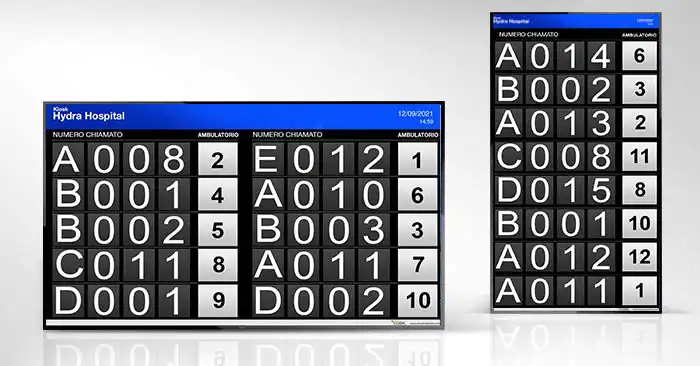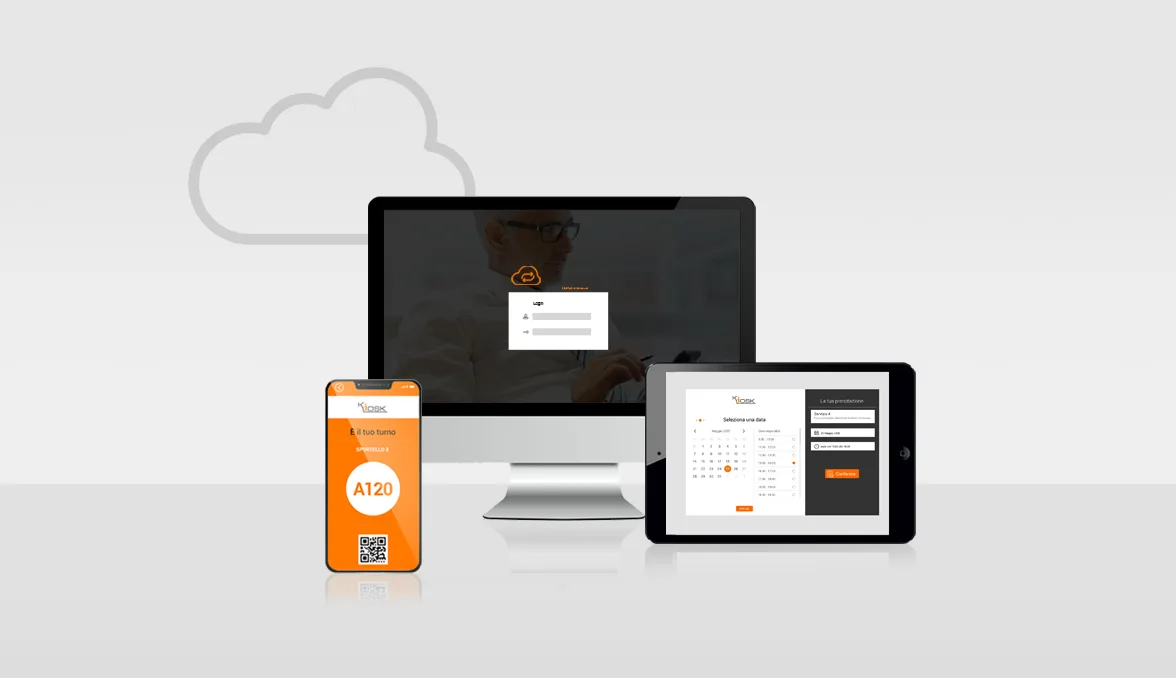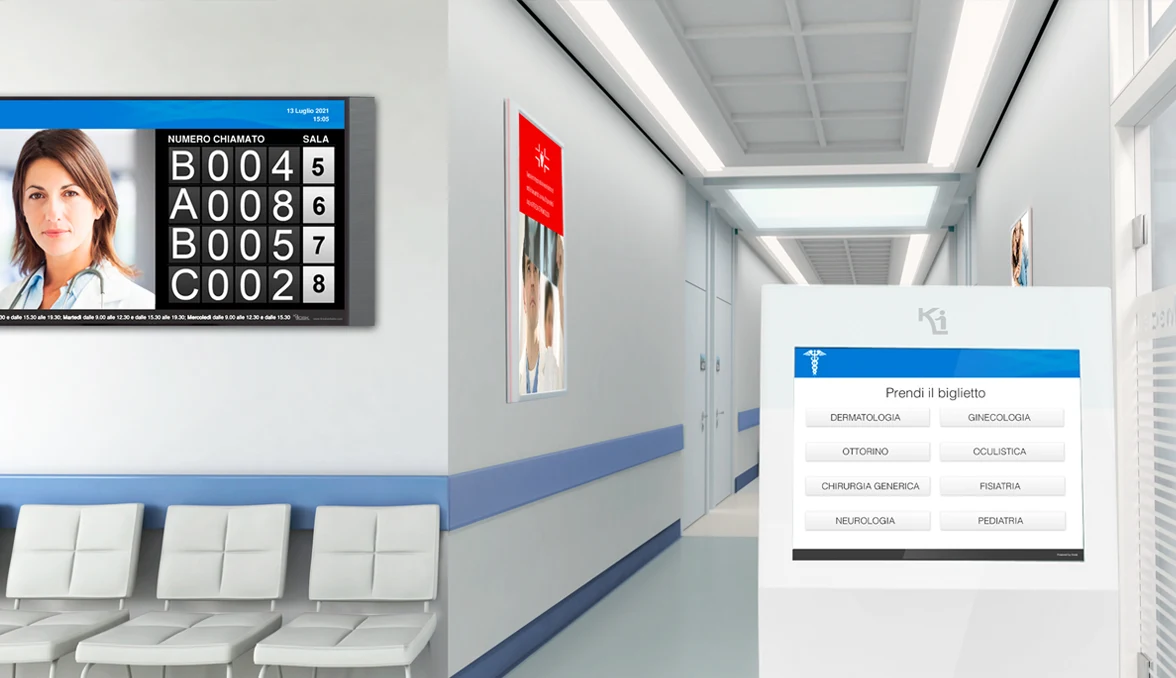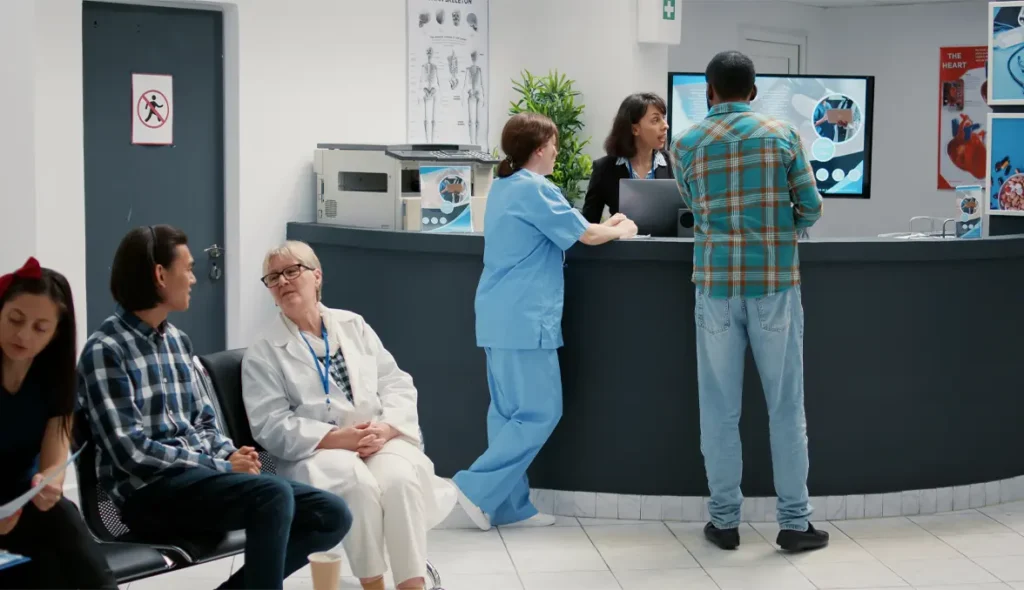In doctors’ surgeries, one of the crucial elements for providing a high quality service is queue management. An orderly and well-planned environment can make all the difference in patient care and overall patient satisfaction.
In this post, we will explore the benefits of efficient queue management in medical practices and how the evolution of totem systems, including online booking, is revolutionizing the patient experience, with an ever-increasing focus on patient journey, that is, the various phases that the patient goes through from the onset of symptoms, with the first medical visit to the conclusion of the treatment.
Benefits of orderly queue management
Queue management in doctors’ surgeries has become particularly important today due to various factors and changes in the healthcare sector and society.
Factors such as increased demand for health services, linked to the aging of the population, the linked to the aging of the population, the, equivalent to optimizing the utilization of resources, including doctors, nurses and outpatient spaces, a better management of emergencies and safety, just think of the pandemic, these are factors that have required attention and consideration at various tables.
To effectively manage queues in doctors’ surgeries, many facilities are adopting queue management systems and advanced technological solutions for multiple benefits, including:
1. Reduced waiting time: one of the main complaints from patients concerns the time spent in the waiting room. With a well-structured queue management system, the patient flow can be optimally organized, which significantly reduces the waiting time.
2. Increased efficiency: an efficient queue management system allows healthcare workers to schedule appointments in advance, evenly distributing the workload and predicting wait times. This allows you to maximize productivity and reduce the risk of staff overload.
3. Improve patient care: well-organized queue management allows doctors to dedicate more time to each patient, listening to their concerns and providing personalized care. Greater attention can lead to better diagnosis and more accurate treatment.
4. Increased patient satisfaction: by reducing wait times and improving the quality of care, patients will feel more appreciated and understood. Patient satisfaction is critical to maintaining a positive reputation for the medical practice.
The evolution: from telephone booking to online booking
With the advent of advanced technologies, traditional paper appointment records are rapidly giving way to increasingly sophisticated digital solutions that can help healthcare facilities meet growing patient needs and maintain high standards of care.
We thus have different technological adoptions:
1. Self Check-in totems: self check-in totems have become a common choice in modern doctor’s offices. They allow patients to self-register upon arrival by entering their data into the system and selecting the desired doctor or service. This speeds up the registration process and reduces the need for staff to handle check-ins.
2. Online booking: with the advent of online platforms, booking appointments has become much easier. Patients can book appointments through the doctor’s office website or using dedicated apps. This offers greater convenience and flexibility, allowing patients to choose the times that best suit their needs.
3. Notifications and reminders: online booking systems can automatically send notifications and reminders to patients via SMS or email. This reduces the number of absences and delays, ensuring that appointments are met on time.
4. Patient flow monitoring: modern queue management systems can monitor patient flow in real time. This allows staff to react promptly to any changes or emergencies and to maintain an efficient working environment.
Queue management in doctors’ surgeries is essential to offer high quality service and patient care. With the adoption of digital solutions such as self check-in totems and online booking, it is possible to optimize the workflow and improve the patient experience. Technological evolution continues to offer new opportunities to make the healthcare system more efficient and effective, always placing patients’ well-being and health at the center of attention.
Kiosk Hydra: advanced queue management optimization and data analysis
In the panorama of modern solutions for managing queues in doctors’ surgeries, the Kiosk Hydra platform stands out, an innovative cloud-based system that goes beyond simple reservation management.
In addition to offering an efficient queue management mechanism, Kiosk Hydra also provides valuable analytical data to support human resource management and optimize the services offered.
The key features of Kiosk Hydra
- Intuitive Queue Management: Kiosk Hydra features an intuitive and user-friendly user interface that allows patients to register quickly and independently via self-check-in totems. With an integrated online booking system, patients can choose the appointment time that best suits their needs, greatly simplifying the registration process.
- Patient Flow Monitoring: thanks to Kiosk Hydra, medical staff and operators can monitor patient flow in real time. This constant monitoring allows you to quickly identify any problems or delays, allowing timely interventions to maintain the efficiency of the clinic.
- Advanced Data Analytics: one of Kiosk Hydra’s distinguishing features is its ability to collect and analyze detailed data regarding patient flow and resource utilization. This analytical data is essential for making informed HR planning decisions, identifying the busiest time slots and optimizing the working hours of doctors and staff.
- Patient Satisfaction Measurements: Kiosk Hydra also includes tools for measuring patient satisfaction. After the visit, patients can be asked to fill out short surveys to provide feedback on the service received. This satisfaction data can be used to continuously improve the quality of care and the overall patient experience.
- Virtual waiting room management: with Kiosk Hydra, you can implement a virtual waiting room that allows patients to receive notifications via SMS or app when their turn is approaching. This helps reduce the number of people in the waiting room, helping to maintain a safe environment, especially during times of health emergencies.
Advantages of Kiosk Hydra for Doctors’ surgeries
- Resource optimization: thanks to the analytical data provided by Kiosk Hydra, medical practices can make strategic decisions to optimize human resources, minimizing downtime and maximizing efficiency.
- Improved patient experience: efficient queue management and the possibility of online booking reduce waiting times and improve patient satisfaction, who feel valued and cared for.
- Reduced errors: by reducing the need to manually manage appointments and reservations, Kiosk Hydra helps avoid human errors and simplifies the work of staff.
- Saving time and resources: with less time spent managing queues, staff can focus more on patient care, improving the quality of overall healthcare services.
In conclusion, Kiosk Hydra represents a significant evolution in the field of queue management in doctors’ offices. In addition to providing flawless organization of bookings and patient flows, the platform offers advanced analytical tools that enable more efficient management of human resources and constant improvement of the patient experience.
The importance of a waiting room with clear shift messaging
 The waiting room is the first point of contact between patients and the doctor’s office.
The waiting room is the first point of contact between patients and the doctor’s office.
Proper management and clear messaging of shifts at this stage can have a significant impact on patient satisfaction and the efficiency of practice operations.
Let’s see why a waiting room with clear shift messaging is so important:
1. Reduced anxiety and stress: waiting in the room can be a source of anxiety and stress for many patients, especially when they don’t know exactly how long they will have to wait. Clear and regular shift messaging reassures patients, allowing them to plan their time and reducing the stress associated with uncertainty.
2. Improve the patient experience: a positive experience starts in the waiting room. When patients feel informed and well managed, their overall satisfaction with the doctor’s office increases. Effective shift messaging can help create a welcoming and professional environment.
3. Greater operational efficiency: a waiting room with clear shift messaging allows staff to work more efficiently. Patients can be alerted when their turn is approaching, allowing staff to organize visits in an optimal way and reducing waiting times.
4. Improved resource planning: shift messaging allows you to monitor patient flow and the average duration of visits. This information helps to better plan resources, properly allocating staff and reducing possible delays or overloads.
5. Increase transparency: clear communication of shifts creates transparency and trust between staff and patients. Patients feel considered and informed, while staff can work in a more collaborative environment and share crucial information.
6. Less crowding in the waiting room: when patients are informed about waiting times and called at the appropriate time, crowding in the waiting room is reduced. This is especially important in situations where social distancing needs to be maintained or during busy times.
7. Reduce absences and delays: timely alerts of scheduled shifts reduce the risk of patient absences or delays. This not only optimizes the scheduling of visits but also ensures that patients receive the care they need without wasting time.
We can conclude that a waiting room with clear shift messaging is crucial to ensure a positive and professional patient experience, improving overall satisfaction and efficiency of operations in the medical office.
Optimal management of waiting times and transparent communication help create a welcoming and organized environment, demonstrating attention to patients and their well-being.

The effectiveness of a cloud queue management solution
Imagine walking into an outpatient clinic or hospital, often crowded with patients waiting to be treated. Traditional queue management methods, such as signs or hand-distributed numbers, can cause confusion and long waits, increasing the level of stress and frustration for both patients and healthcare staff.
This situation is particularly critical in healthcare settings, where efficient queue management is essential to ensure high quality service and patient well-being.
That’s where the innovation of the cloud queue management solution comes into play. Adopting this modern technology means embracing change and responding to today’s needs, offering a series of advantages that significantly improve the experience of both patients and medical staff.
First, the cloud-based nature of the solution allows for easy and flexible access for patients. This means patients can book appointments online from home, through a mobile application or from their computer. There is no longer any need to physically show up at the clinic to book your shift, thus reducing queues and simplifying the process for everyone.
Automatic notification of appointment times is another key benefit of this innovation. Patients receive an email reminder or notification on their mobile device notifying them of the exact time of their appointment. This not only reduces absences and delays, but also allows patients to organize themselves better, avoiding long unproductive waits.
For medical personnel, the cloud solution offers greater operational efficiency. Staff can monitor queue status and resource occupancy in real time, thus optimizing the scheduling and allocation of doctors and equipment. This results in better resource management and shorter wait times for patients.
Furthermore, data security is a major concern in the medical field. The cloud solution offers greater data security than traditional methods. The data is securely stored on remote servers, with advanced security procedures and encryption protocols. This ensures that patients’ personal information is secure and can only be accessed by authorized personnel.
Finally, the positive image that the hospital or surgery projects by adopting this innovation can be an important competitive advantage. Demonstrating a commitment to technological innovation and patient satisfaction can increase patient confidence and attract new clients.
In conclusion, adopting a cloud queue management solution in a clinic or hospital means choosing innovation and responding to today’s needs. Reduction of waiting times, operational efficiency, data security and a positive image are just some of the benefits that this technology offers.
This innovation represents a step forward in improving the patient and medical staff experience, guaranteeing a high quality service and a more serene and organized environment for everyone.
The integration of a queue management system with a reservation system
The integration of a queue management system with a reservation system
1. Advance resource scheduling: with a cloud booking system, patients or customers can book appointments in advance. This allows staff to schedule resources more efficiently, anticipating peak traffic and reducing downtime.
2. Even distribution of workload: thanks to advance booking, the workload can be distributed evenly among staff members. This avoids overload or underutilization of human and structural resources, improving overall productivity.
3. Reduce waiting times: by integrating a booking system with your queue management system, you can optimize the flow of patients or customers, reducing waiting times and improving their overall experience.
4. Real-time monitoring: cloud queue management and booking systems allow real-time monitoring of the flow of patients or customers. This allows staff to be more responsive and to adapt quickly to any changes or emergencies.
5. Removing physical queues: integrating a cloud booking system allows patients or customers to self-register or book their appointments in advance. This reduces the need for physical waiting room queues, improving social distancing and creating a cleaner environment.
6. Greater data analysis opportunities: A cloud queue management and booking system collects detailed data on the flow of patients or customers. This data can be analyzed to gain valuable insights into resource management, average hold times, and other performance metrics. These analyzes allow you to make targeted improvements and make informed decisions to further optimize your resources.
7. Reduce errors: automating processes through a cloud queue management and booking system reduces the risk of human errors, such as appointment overlaps or duplicates.
In conclusion, integrating a queue management system with a cloud reservation system offers an excellent opportunity to optimize resource efficiency in an organization. Thanks to advance booking, real-time monitoring and the ability to analyze data, staff can be managed more efficiently, improving the service offered to patients or customers and creating a more organized and efficient work environment.
 | Don’t wait any longer!Want to find out more about Kiosk Hydra and how it can optimize queue management in your practice? Contact us today for more information and to book a personalized demo. We’d be happy to show you all the advanced features of our platform and how it can improve your patient experience and internal resource management. Don’t miss this opportunity, contact us now! |
 |
Don’t wait any longer!Want to find out more about Kiosk Hydra and how it can optimize queue management in your practice? Contact us today for more information and to book a personalized demo. We’d be happy to show you all the advanced features of our platform and how it can improve your patient experience and internal resource management. Don’t miss this opportunity, contact us now!
|



